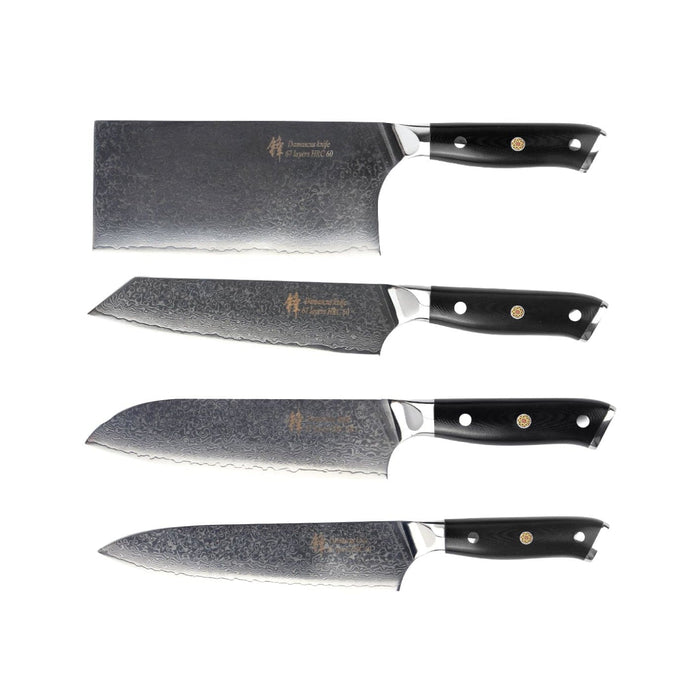
Damascus steel knife 4 piece set with Bonus Whetstone And Angler
Upgrade your kitchen arsenal with our Damascus Knife Set. This set includes four essential knives crafted with Damascus steel blades, known for their exceptional sharpness and durability. Each knife is designed for specific cutting tasks, ensuring you have the right tool for every culinary challenge.
This set includes:
- 7″ (18cm) Santoku Knife
- 7″ (18cm) Nakiri Knife
- 7″ (18cm) Chopper Knife
- 8″ (20cm) Chef Knife
Key Features:
- Set includes 7″ Santoku knife, 8″ Chef knife, 7″ Nakiri knife, and 7″ Chopper knife
- Damascus steel blades for superior sharpness and durability
- Ergonomic handles for a comfortable and secure grip
- Ideal for slicing, dicing, chopping, and more
- The perfect balance of style and functionality
1. Santoku Knife
I Have 3 Uses. The longer blade on this knife suits people with all types of experience. Slightly shorter, lighter and more narrow than a chef’s knife, but equally as versatile and strong. They are predominantly used for cutting, slicing and chopping and tend to have a straight bevelled edge (they are traditionally sharp on one side) and a curved tip. These guys originated from Japan, unlike the chef’s knife that originated in Germany and France.
Santoku Knives are best suited for:
- Slicing, dicing or chopping fruits, vegetables and nuts
- Mincing herbs and meat
- Cutting meat and boning fish (some varieties)
- Scooping food off a chopping board
- Creating fine vegetable and seafood slices
Santoku Knives are not suited for:
- Small precision tasks
- Slicing bread
- Cleaving meat bones (not typically)
2. Nakiri Knife
The Pristine Performer. They may look similar to the Santoku Knife, but they have a flat blade to allow you to cut right through to the chopping board, without needing the rocking motion like the Santoku. It has a slightly long, rectangular blade so it is great for controlling your cuts and using it for long, rounded/thin vegetables.
Nakiri Knives are best suited for:
- Chop and dice vegetables (celery, onions, leeks, carrots, eggplant etc..)
- Cutting fruits
- Precision cutting with softer fruits/vegetables
Nakiri Knives are not suited for:
- Butchering bones or meat
- Carving meat
- Slicing bread
3. Chopper Knife
The Tough Guy. They look almost axe-like with their wide, flat and rectangular shaped blade. They are quite the workhorse and can make chopping up raw meat and hacking through soft bones easy. They do have a gentile side for crushing garlic or ginger against a chopping board and they have been known to make easy work of a large Jap Pumpkin or a young coconut.
Cleaver Knives are best suited for:
- Cutting raw meat into smaller portions
- Cutting open large, hard vegetables & fruits such as pumpkin and young coconut
Cleaver Knives are not suited for:
- Slicing meats, vegetables, fruits
- Small precision tasks
- Slicing bread
4. Chef’s Knife
The Ultimate Professional. These guys look the part. They have a broad, sharp blade that can be used for a variety of tasks. It’s the go-to knife for any type of cutting, chopping and dicing fruits, vegetables and meat. The blade is rounded at the tip and they enjoy the rocking motion as they make light work of anything you give them!
Chef’s Knives are best suited for:
- Cutting, chopping, dicing vegetables & fruits
- Cutting shapes in pastry and cookie dough
- Chopping and mincing herbs and spices
- Scooping food off of the chopping board
- Chopping and preparing meats
- Crushing garlic
- Scaling fish
Chef’s Knives are not suited for:
- Butchering bones or meat
- Carving meat
- Slicing bread

